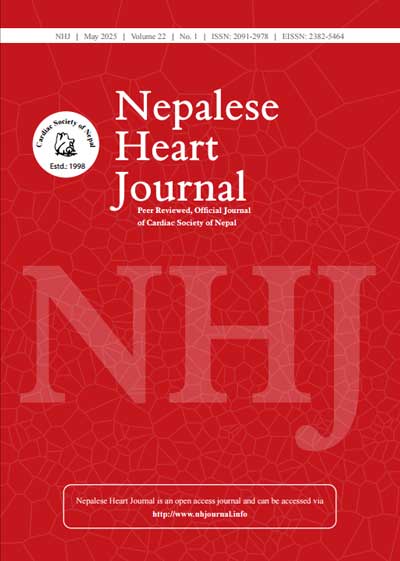Manuscript must be written in English. Whenever there is any doubt, authors should seek the assistance of experienced, English-speaking medical editors. A medical editor should review the final draft of the original and any revision of the manuscript.
NHJ has following outlines for paper presentation and formats.
- Use single spacing throughout
- Pages should have margins at least 25 mm and be numbered
- Maintain the sequence title page, abstract, key words, text, acknowledgements, references and legends.
- Text should be presented as per the nature of paper
- The Cover page should carry the title, a short running title, total words count on abstract, total word count of manuscript, information of any disclaimers or funding bodies and the corresponding author’s full names, qualifications, affiliations, departments, email and addresses of institute affiliated (street, city, country)
- Authorship page should carry in sequence information on primary author, corresponding author, and other authors, with authors’ full names, qualifications, affiliations, departments, email and addresses of institute affiliated (street, city, country)
- Declaration page must be scanned and sent with signature of all authors.
- Include permission to reproduce previously published material or to use illustrations that may identify participants
USE OF LANGUAGE
- Uniformity in Language is required, with preference to British English
- There should be no abbreviation in Abstract
- Abbreviation spelt out in full for the first time
- Avoid repetition of same words and waste words
- Do not use ‘&’ and ‘@’ in the text
- Running title provided should be not more than 50 characters
- Format the manuscript in a single column
- Do not use any special typeface for emphasis
USE OF NUMBERS
- Numbers less than 10 should be written in words.
- Numbers 10 or more should be written in numbers.
- Words not numbers begin a sentence.
- Be consistent in lists of numbers.
- Numbers less than 1 begin with a zero.
- Do not use a space between a number and its percent sign.
- Use one space between a number and its unit.
- Report percentages to only one decimal place if the sample size is larger than 100.
- Do not use decimal places if the sample size is less than 100.
- Do not use percentages if the sample size is less than 20.
- Do not imply greater precision than your measurement instrument.
- For ranges use “to” but not “–” to avoid confusion with a minus sign and use the same number of decimal places as the summary statistic.
- Rules for data numbers do not apply to citations to the literature
- Use the metric system throughout; use of appropriate SI Units is encouraged. If using other, more commonly used units, give the SI equivalent in parenthesis.
USE OF TABLES, FIGURES AND IMAGES
- Tables, Figure and Images number in Arabic letters (no Romans)
- Title/legends provided in no more than 40 words.
- For borrowed materials – credit note must be provided in the figure/table/image itself.
- Keep the table/figures simple and uncluttered as possible.
- Standard abbreviation of units of measurement should be added in parentheses
Use of Tables Rule of thumb: Use tables to present data that is detailed and that is important - Avoid tables created with the tab key, pictures, and embedded objects
- Fancy borders, shading, 3d effects, multiple grids are both distracting and unnecessary.
- Prefer grey shades of tables and figures
- Scientific table have few horizontal lines and no vertical lines. Usually only three horizontal lines (above and below the column headings, below the table)
- Tables should be formatted so that they have to be read horizontally (left to right) – the natural reading style
Use of Figures Rule of thumb: Use figures to - Show trends in data (as graphs) - Do not use Pie charts, 3d bar diagrams, as Figures
- Figures should be simple to interpret, uncluttered, and free of extra lines, text, dimensions and other gimmicks.
- Prefer common data-presentation formats in figures: Column charts/bar charts; Line charts; Scatter plots
Use of Images/photographs - Do not create math equations or tables as pictures
- For Images and photographs, use TIFF or a high resolution JPEG.
- Figures necessitate good quality – 300dpi with minimum resolution of 800x600 pixel
Relating to tables and figures in text - Refer to all the tables/figures in the text
- Point out the relevant part(s) of a table/figure when referring to it
- Do not restate all the information from tables/figures in the text of the paper
- Tables/figures should not be used to highlight what has already been said in the paper

